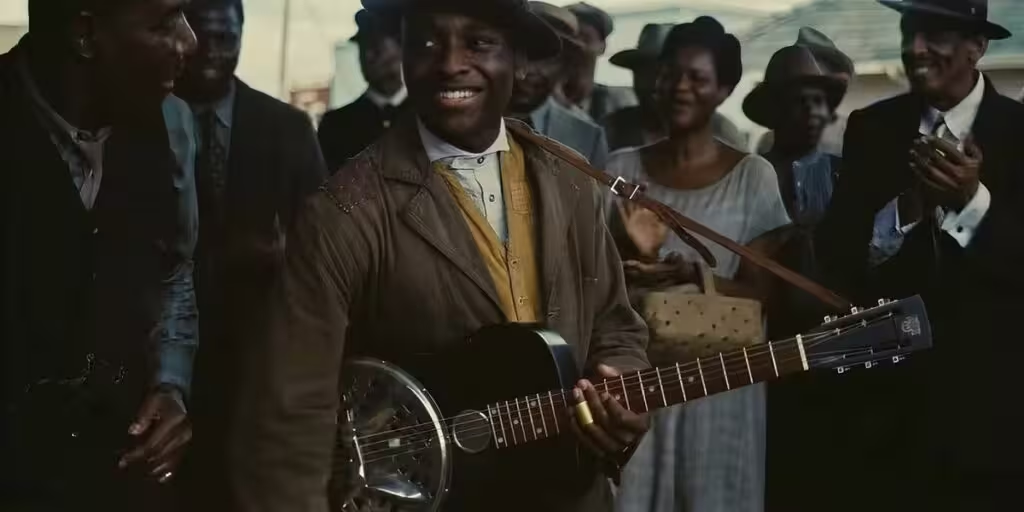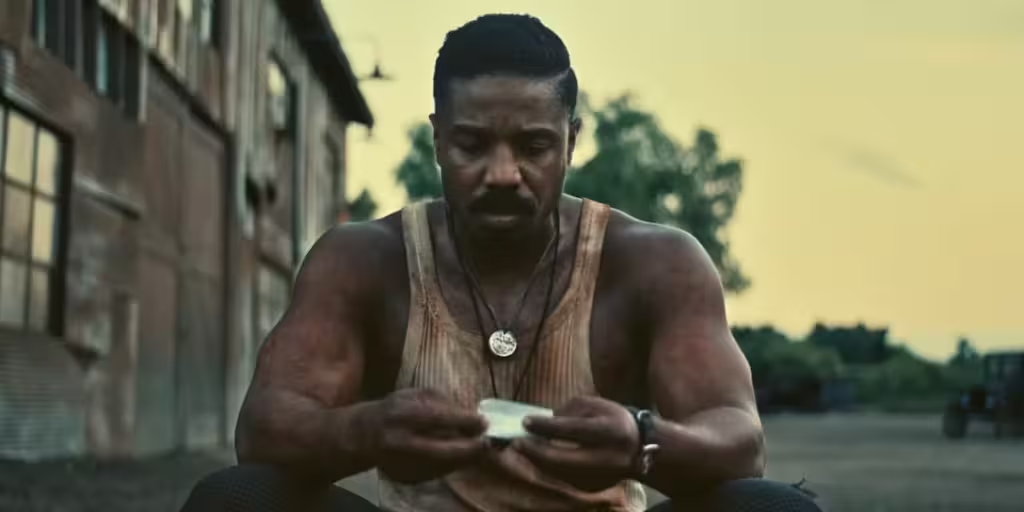7 Minutes
Music in cinema has long been a powerful tool for breaking boundaries, evoking emotion, and even bending the flow of time onscreen. Ryan Coogler’s latest film, Sinners, leverages music—particularly the evocative blues of the American South—not just as a backdrop, but as an active force that shapes characters, histories, and destinies. This film stands out in the landscape of contemporary cinema, blending elements of historical drama, music, supernatural horror, and sharp cultural critique. For Lithuanian movie and series fans seeking an original, multilayered viewing experience, Sinners offers a masterclass in genre fusion and storytelling.
Plot Summary: Mississippi Delta’s Melancholy and Magic
Set in the turbulent 1930s deep South, in the Mississippi Delta, Sinners opens in Clarksdale—a city infamous for its legacy of Jim Crow laws, racial violence, and strict religious norms. Against this backdrop of oppression and desperation, the blues emerges as the soulful soundtrack of survival and longing. At the film’s heart are the Twin brothers, Smook and Stack, portrayed with riveting duality by Michael B. Jordan, and their musically gifted cousin Samuel.
After building a reputation in Chicago’s underworld, the twins return to their roots in Mississippi, determined to create a sanctuary for Black joy, artistic freedom, and, above all, the burgeoning sounds of Delta blues. Their dream: host a legendary party that becomes both a declaration of independence and resistance to social, religious, and economic pressure. Samuel, a prodigy on the guitar, is swept into the world of his rebellious elders—a world that teeters on the line between creative euphoria and societal scapegoating.
The first half of Sinners roots itself in gritty historical realism. Using sharp dialogue, period-accurate set design, and a soundtrack that thrums with hope and heartache, Coogler draws audiences into a world where music is salvation, but also temptation. The film doesn’t shy from depicting the violence and prejudice faced by African Americans, making their moments of joyful defiance all the more profound.

The Supernatural Twist: Sinister Revelations on the Dance Floor
In a bold narrative turn, the second half introduces supernatural elements that elevate the story into an allegorical space. As the party builds to a fever pitch, a white vampire—a chilling symbol of cultural appropriation and exploitation—arrives, unleashing chaos with an undead army. With this audacious blend of horror, musical spectacle, and intense action sequences, Sinners refuses to be pinned to a single genre. The result is a wild, mesmerizing cinematic experience where the literal and metaphorical collide.
For those familiar with the real blues legends and the folklore of the Delta, Coogler’s script is rife with symbolic depth. The vampire, a force that both craves and corrupts Black creativity, can be read as a metaphor for white-dominated music labels, radio, and capitalism’s role in commodifying Black art. The film subtly questions: could blues have achieved its reach and legacy without those who profited from, and distorted, its spirit?
Characters and Cast: Duality, Identity, and Redemption
The film’s character work is as rich as its themes. Michael B. Jordan delivers what may be the defining performance of his career, embodying both charismatic ruthlessness and profound vulnerability in his dual role as the twins. Samuel—portrayed by rising star Elijah Brooks—serves as the audience’s conduit, discovering both the euphoria and peril of musical rebellion.
One of the film’s most compelling relationships is that between Samuel and his conservative father—a preacher adamantly opposed to secular music. In their clash, Coogler explores the complex interplay of faith, fear, and hope that has long characterized African American cultural history. For Samuel’s father, the guitar is the very tool of the devil; for Samuel, it’s a pathway to self-actualization and liberation.
Supporting performances—especially from a cast of real blues musicians in cameo roles—bring authenticity and lived-in energy to Sinners. The on-screen ensemble breathes life into every communal moment, every jam session, every confrontation between spirituality and artistry.

Production Details: Creating the World of Sinners
Ryan Coogler, renowned for blockbuster hits like Creed and Black Panther, breaks new ground with Sinners. Free from the limits of franchise expectations, he crafts a visually striking film full of atmospheric detail—switching from sweat-soaked churches to sinister juke joints, from haunted plantations to the neon-lit chaos of the fateful party. Cinematographer Autumn Durald Arkapaw imbues each frame with moody blues, golden candlelight, and inky shadows.
The film’s sound design is equally immersive, with a soundtrack that blends original compositions with classic blues cuts from legends like Charley Patton and Robert Johnson. During key sequences, music serves not just as ambient sound but as a storytelling device—warping perceptions, conjuring spirits, and erasing the boundaries between past and present. Sinners also pays subtle homage to the mystical origins of the blues, invoking elements of African voodoo and magical realism.
Critical Reception: A Film that Divides and Provokes
Since its festival debut, Sinners has sparked lively debate among critics and audiences. Many praise the film’s risk-taking, thematic complexity, and innovative use of genre. Reviewers have highlighted Michael B. Jordan’s career-best performance and the hypnotic musical segments as particular standouts. For lovers of music-centric movies and historical dramas, Sinners is being hailed as a cult classic in the making.
However, some viewers may find its layered symbolism and narrative shifts challenging. The supernatural elements, while rich in meaning, may feel jarring for those expecting a straightforward drama. Coogler’s refusal to tie his story in tidy bows ensures that Sinners provokes reflection and inspires discussion long after the credits roll.
Audience Reactions
Viewing Sinners is an immersive, at times overwhelming, experience. For many, especially those drawn to films about race, music, and identity, its ambiguities are a strength rather than a weakness. Lithuanian viewers with a passion for soul-stirring cinema and genre-bending storytelling are likely to find themselves enthralled by the film’s audacity.

Themes and Symbolism: From Damnation to Liberation
At its core, Sinners uses music not just as a symbol of pleasure or defiance, but as a force of transcendence. The film directly highlights how blues was often condemned by church leaders as the “devil’s music,” and how, for the Black community, it became an instrument of healing and resistance. The climactic party is both a site of supposed sin and a landmark moment of collective freedom. Coogler asks his audience to wrestle with a key question: where does sin end and emancipation begin?
The vampires, meanwhile, are more than mere monsters—they represent the systems and individuals who have historically profited from Black creativity while stifling its true meaning. Sinners is never content to simply point fingers; instead, it explores the tangled realities of appropriation, collaboration, and the struggle for authentic expression in a world rife with prejudice.
Personal Take: Sinners’ Enduring Power for Viewers
On a personal level, Sinners stands out as a film that commands multiple viewings. With each watch, new connections, references, and meanings reveal themselves. It draws from the full history of American music, from gospel shouts to rock and roll, echoing the ongoing tension between innovation and conformity, tradition and rebellion.
Coogler’s direction—especially in musical ensemble scenes—blurs the lines between past, present, and future, much like the magical realism in classic voodoo lore. He demonstrates that storytelling through film and music can collapse centuries of pain and possibility into a single, unforgettable night.

Conclusion: A Defiant, Soulful Addition to Modern Cinema
Ultimately, Sinners is an ambitious, boundary-pushing entry in the world of music-driven film and social drama. It successfully weaves together horror, historical reality, and musical celebration, offering something deeply resonant for both enthusiasts and scholars of Black American culture and the broader art of cinema. Both a tribute to the redemptive power of the blues and a sharp critique of the forces that shape cultural destiny, Sinners is a must-see for every serious film lover. Ryan Coogler has firmly cemented his status as a director with vision and verve, capable of challenging Hollywood norms and reinventing genre conventions with a single, unforgettable story.
For Lithuanian audiences passionate about movies, series, and the arts, Sinners offers a thrilling, thoughtful, and utterly unique experience—one that invites us all to listen closer, question more deeply, and celebrate the wild, beautiful mess of music and meaning.


Comments